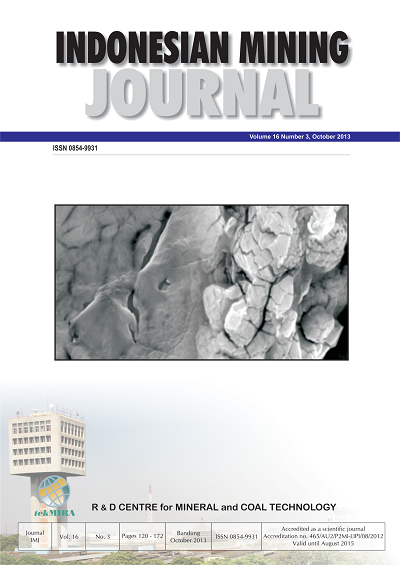COMPUTATIONAL ANALYSIS OF ASH EROSION ON SUPERHEATER TUBES IN COAL FIRED POWERPLANT
DOI:
https://doi.org/10.30556/imj.Vol16.No3.2013.380Keywords:
coal ash, erosion, superheater tube failure, mathematical model, computational fluid dynamics simulationAbstract
This paper presents a computational analysis of fly ash erosion on superheater tubes of a coal furnace. The investigation was held based on a hypothesis that erosion by coal ash particles have caused an untimely fail- ure of a superheater tube during the initial running of a relatively new coal fired power plant. Material erosion is usually caused by several corresponding factors, therefore, it is necessary to examine the process taken by the coal ash to wear out superheater material before conclusions on the ash factor are drawn. This work applies a combination method of analysis using mathematical model and computational fluid dynamics (CFD) simulation. The mathematical model was used to calculate the amount of erosion by the fly ash particles and CFD simulation was employed to examine the velocity profile of combustion products around the superheater bank. The CFD simulation was based on the real scale and the design parameters of the power plant. The simulation shows that the velocity vector of the combustion products around superheater bank varies from 1 to 20 m/s magnitude with impacting angle varies from 0 to 90° relative to the vertical position of the superheater. Ash data were taken from the actual coal used during the operation and the design specified coal according to the equipment specification. Mathematical model was formulated for a single ash particle and for ash bulk. The results show that differences in the ash particle parameters result in different amount of material removal which means that ash particles affect the wear out of the material. As an overall, for each ash particle, the maximum erosion occurs at impacting angle of 17°. The impacting angle is used further in determining the amount of mass removal by varying the velocity and the abrasiveness of ash particles. At the maximum level of erosion, which is the maximum velocity calculated from the CFD simulation (20 m/s), every kilogram ash particles containing 46.54 % SiO2 with ash particle average diameter 500 micron is capable to remove about 0.0045 miligram alloy steel material. The maximum penetration of the ash particles into the superheater material is found at the maxi- mum velocity obtained from the CFD simulation that is 20 m/s. The maximum penetration is 0.049 mm which is about 1.53 % of the pipe thickness. The superheater pipe is made of alloy steel material type A213-T91 with the thickness of pipe wall 3.2 mm. The magnitude of mass removal is considered relatively trivial to cause the thinning of material in a short period. This proves that coal ash particles will undergo a timely process to wear out superheater material, it is predictable and does not immediately cause erosion or failure. A brief physical examination was carried out to compare the results of the analysis and the causes of failures. It was found out that the failed superheater pipe had undergone clogging which caused overheating followed by pipe burst.
References
ASTM-A213-T91-ASME-SA213-T91-specification Boardman, B., 1990. Fatigue Resistance of Steels, ASM Handbook, Volume 1: Properties and Selec- tion: Irons, Steels, and High-Performance Alloys, p. 673-688.
Certificate of Coal Sampling and Analysis, (2010) Finnie, I., 1960. Erosion of surfaces by solid particles, Wear 3, p. 87-103.
Finnie, I. and McFadden, D.H., 1978. On the velocity dependence of the erosion of ductile metals by solid particles at low angles of incidence, Wear, 48, p . 181 - 190.
Gong, Y., Zhong, J. and Yang,Z.G., 2010. Failure analy- sis of bursting on the inner pipe of a jacketed pipe in a tubular heat exchanger, Materials and Design 31, p. 4258–4268.
Mbabazi, J.G., Sheer, T.J. and Shandu, R., 2004. A model to predict erosion on mild steel surfaces impacted by boiler fly ash particles, Wear 257, p. 612–624.
Mbabazi, J.G. and Sheer, T.J., 2006. Computational prediction of erosion of air heater elements by fly ash particles, Wear 261, p. 1322–1336.
Port, R.D. and Herro, H.M., 1991. The Nalco Guide to Boiler Failure Analysis, Nalco Chemical Company, McGraw-Hill, Inc., New York, p. 29-31.
Boiler Specification, 2008. Project Document Equip- ment Specification.
Purbolaksono, J., Ahmad, J., Khinani, A., Ali, A.A. and Rashid, A.Z., 2010. Failure case studies of SA213- T22 steel tubes of boiler through computer simula- tions, Journal of Loss Prevention in the Process Industries 23, p. 98–105.
Rahimi, M., Abbas Khoshhal, A. and Shariati, S.M., 2006. CFD modeling of a boiler’s tubes rupture, Applied Thermal Engineering 26, p. 2192–2200.
Sandberg, J., Fdhila, R.B., Dahlquist, E. and Avelin, A., 2011. Dynamic simulation of fouling in a circulating fluidized biomass-fired boiler, Applied Energy 88, p. 1813–1824.
Vuthaluru, H.B. and Vuthaluru, R., 2010. Control of ash related problems in a large scale tangentially fired boiler using CFD modelling, Applied Energy 87, 1418–1426.
Downloads
Issue
Section
License
Indonesian Mining Journal provides immediate open access to its content on the principle that making research freely available to the public to supports a greater global exchange of knowledge.

This work is licensed under a Creative Commons Attribution-NonCommercial 4.0 International License.













